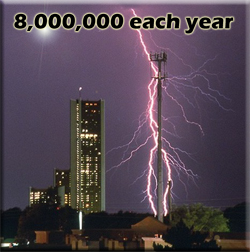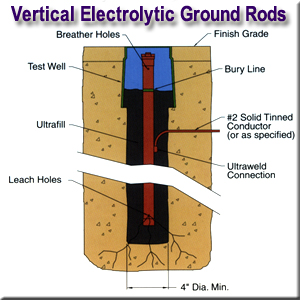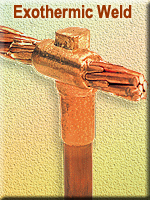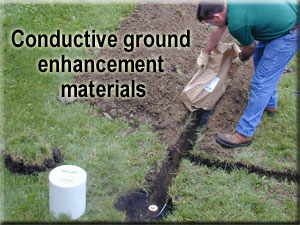|
Grounding for tower lightning protection systems
more than just low ground resistance
By Curtis R. Stidham
Lightning is an awesome, naturally occurring event that causes thousands of injuries and deaths, as well as billions of dollars in property loss annually. Though unpredictable, lightning is a very common event around the world. The frequency of lightning stroke occurrences (lightning flash density) increases as the Earth’s equator is approached. There are over 40,000 storms every day producing over eight million lightning strokes resulting in fires, damage to buildings, and breakdowns to electrical, telephone and computer installations, which cause considerable losses in operational revenues and customer dissatisfaction is approached. There are over 40,000 storms every day producing over eight million lightning strokes resulting in fires, damage to buildings, and breakdowns to electrical, telephone and computer installations, which cause considerable losses in operational revenues and customer dissatisfaction
Damage results from electromagnetic fields from the lightning stroke, voltage differentials in ground systems, and structural damage from ohmic heating or mechanical forces. This damage can be attributed to insufficient direct strike protection, inappropriate grounding and bonding that permit lightning currents to flow near susceptible electronics, and deficient Transient Voltage Surge Suppression (TVSS) protection.
What can be done to protect personnel and capital investments? The best approach to prevention is a properly designed and installed lightning protection (LP) mitigation system - reference NFPA780, UL 96 and UL96A for LP equipment and proper installation procedures. The foundation upon which the LP system is built is a properly designed grounding electrode system, complemented with proper bonding practices to create an equipotential plane and the application of TVSS to all power, communication and data signal lines. TVSS protectors are used to suppress the surge over-voltage and dispense the excess energy using a variety of technologies. For the protection of utility distribution lines, surge arrestors are used.
To properly implement a LP system, the designer needs to understand the nature of lightning and the implications to electrical grounding. The properties of a lightning stroke are indeed impressive, with an instantaneous power of over one Megawatt and, on average, a peak current level of 30,000 Amperes. While the average current is 30,000 Amperes, strokes have been measured over 100,000 Amperes. The channel of the stroke has a temperature of approximately 50,000° F or five times that of the Sun [1].
There are three main lightning interactions that the designer needs to consider. First is the direct lightning stroke; this is when the stroke terminates on the facility. Second is the near stroke, where the lightning stroke induces large voltage impulses in metal conductors, either due to magnetic induction or capacitive coupling. Capacitive coupling can also occur due to cloud-charge buildup. Finally ringing results occur when a tuned cable captures similar frequencies from the radiated stroke. Since lightning has a broad spectrum of high frequencies, it can induce a large impulse onto the wave-guide or coaxial system at its tuned spectrum causing equipment malfunction or damage. The primary protection scheme for ringing is surge suppression.
The most popular methods of lightning protection have involved the use of passive Franklin air terminals, horizontal and vertical conductors (Faraday Cage) or combinations of both. For utility substations, transmission and distribution networks, catenary systems and static lines are employed. The LP system is dependent on the ground electrode system to effectively dissipate lightning energy into the earth, therefore the LP system cannot function properly without a good ground. The characteristics of a ground system under the impulse conditions of a lightning stroke are important if an effective LP ground system is to be implemented. The significance is to ensure that the grounding system provides low ground impedance and not just a low resistance. This point is central to the philosophy of LP ground system design. The impulse from a lightning stroke is comprised of both high frequency and low frequency components. The wave shape of the impulse is characterized by a very steep rise in voltage and current followed by a long tail of excess energy content. The voltage and current rise times to peak typically vary between 1 to 10µs for the first stroke, and from 0.1 to 1µs for subsequent re-strokes.
The high frequency is associated with the fast rising front while the lower frequency component resides in the long, high-energy tail. Because of this steep rate of current rise, the inductance of the ground system becomes a central point of the design. The voltage rise, known as Ground Potential Rise (GPR), is dependent not just on the system resistance but also on the impedance (inductive reactance) of the system. The voltage rise can be expressed by the following formula, where I (A) is the instantaneous current, R (Ω) is the system resistance, L (µH) is the inductance of the system, and dI/dt (kA/µsec) is the current rate to peak of the impulse.
It is possible for the injection point on the structure to reach hundreds of thousands or even millions of volts relative to remote earth, due to the lightning stroke. The dominant factor attributed to this large impressed voltage is the product of the inductance and the rapid rate of current from the impulse. It is this type of large voltage rise that leads to the hazard known as flashover – arcing from the LP system to an adjacent metallic conductor due to the dielectric breakdown of air between the conductors. Therefore, a low impedance ground is essential to the performance of the LP system. To the lightning stroke, the ground system appears as a transmission line where wave propagation theory applies.
The ultimate goal of a LP ground system is to dissipate the energy from the lightning stroke into the earth, safely and efficiently. The efficacy of the system is one in which the potential rise of the surrounding earth is minimized and the rate of potential fall from the injection point is maximized. Step and touch potentials are maintained to safe levels and an equipotential ground plane is created to ensure the safety of equipment and personnel. Equipotential bonding is used throughout the installation to eliminate damage caused by differential ground potentials. The National Electric Code requires that the grounds from all systems including, power, cable, telephone, and LP be bonded together.
The LP grounding system must be robust and constructed from materials that will perform for the service life of the building or structure that it is protecting. Inductance and skin effects are the major considerations in selection of conductors, connectors, and installation practices. Radials constructed of flat strip or cable and typically embedded in a ground enhancement material, are the most effective electrodes in  reducing GPR and directing lightning energy away from the point injection. In addition, adding short radials stemming from a main radial will expedite the dissipation of the lightning energy. Typically, the additional radials are installed at an angle of 45 degrees to the main radial and always point away from the lightning injection point. The leaky transmission line model indicates that there is a law of diminishing returns for a given radial and after a length of about 50 to 75 feet, the effectiveness for the amount of material and effort involved is diminished. Other commonly used electrodes include ground rods, plates, and enhanced or electrolytic ground rods. reducing GPR and directing lightning energy away from the point injection. In addition, adding short radials stemming from a main radial will expedite the dissipation of the lightning energy. Typically, the additional radials are installed at an angle of 45 degrees to the main radial and always point away from the lightning injection point. The leaky transmission line model indicates that there is a law of diminishing returns for a given radial and after a length of about 50 to 75 feet, the effectiveness for the amount of material and effort involved is diminished. Other commonly used electrodes include ground rods, plates, and enhanced or electrolytic ground rods.
When designing the LP ground electrode system remember that other systems buried in the earth may be affected or damaged by the energy from a stroke. This is caused by GRP or due to arcing through the soil from the LP grounding network to  other adjacent buried systems. A value of 0.5kV/cm can be used for the soil breakdown mechanism in calculating the separation distances between systems during a lightning stroke [2]. Finally, exothermically welded connections provide the lowest inductance path for high frequency lightning surges while providing the highest level of reliability. They are mandatory for below-grade connections and eliminate the concern of deterioration due to corrosion. other adjacent buried systems. A value of 0.5kV/cm can be used for the soil breakdown mechanism in calculating the separation distances between systems during a lightning stroke [2]. Finally, exothermically welded connections provide the lowest inductance path for high frequency lightning surges while providing the highest level of reliability. They are mandatory for below-grade connections and eliminate the concern of deterioration due to corrosion.
Knowing the resistivity of the soil is important since the resistance of a ground electrode or a complete electrode system is directly proportional to soil resistivity. Reference IEEE Std-81 for information on testing both soil resistivity and resistance to remote earth of an installed ground electrode system. Measurement of ground resistance with conventional ground test instruments may not provide results that are indicative of the ground system's true effectiveness under the impulse conditions of a lightning stroke. Common ground testers operate at low frequencies (hundreds of Hertz). Therefore, they cannot indicate the true surge impedance of an installed ground electrode system. They will still, however, provide invaluable information. The designer needs to know just how conductive the soil is before beginning a design. The resistance of the installed system will contribute to the overall GPR during the transient event; therefore the resistance of the ground should be as low as possible, typically under five ohms. The Fall of Potential Method is most commonly used to measure the resistance of a ground electrode system, though in some situations, clamp-on style ground testers provide invaluable information. In addition, knowing soil resistivity allows the designer to apply what is known about LP grounding conductors and electrodes. For example, if the upper layer is poorly conductive, larger radial wire or strip should be used to reduce the inductance between ground rods, and the spacing between the rods should be decreased.
The change in conductor size and rod spacing is required due to the soil not shunting the radial inductance as it would if this layer were conductive. The impedance of the radial conductors can be greatly reduced by the addition of conductive ground enhancement materials around the conductors. Furthermore, high resistivity soils can cause a high concentration in the electric field around an electrode, which, in turn, may cause arcing in the soil to occur. Such arcing, with its high temperature, will fuse the soil into a glass material (fulgurites). This glass material will no longer be conductive. Glassification of electrodes is a maintenance problem that is often overlooked and can lead to equipment damage. The only way to avoid this is to perform routine measurements and inspections of the ground system. the radial inductance as it would if this layer were conductive. The impedance of the radial conductors can be greatly reduced by the addition of conductive ground enhancement materials around the conductors. Furthermore, high resistivity soils can cause a high concentration in the electric field around an electrode, which, in turn, may cause arcing in the soil to occur. Such arcing, with its high temperature, will fuse the soil into a glass material (fulgurites). This glass material will no longer be conductive. Glassification of electrodes is a maintenance problem that is often overlooked and can lead to equipment damage. The only way to avoid this is to perform routine measurements and inspections of the ground system.
An effective inspection and periodic maintenance program is needed to ensure that continuity exists throughout the ground system. Annual testing or system monitoring is recommended in order to verify that the system is operating at an optimal level. Regular inspections need to be performed using an approved ground test instrument to test both the electrical resistance of the system to remote earth as well as performing continuity tests of the system.
References:
[1] Uman, M., “All About Lightning”
[2] Mousa, A., “Breakdown Gradient of the Soil Under Lightning Discharge Conditions”
 Author Curtis Stidham is the Manager of Product Development and Application Engineering for Harger Lightning & Grounding in Grayslake, Illinois. He has over 20 years of engineering experience in the aerospace and electrical industries. He has nine years of research engineering experience with NASA in the area of environmental effects on space power system components. Programs supported included the International Space Station, Hubble Space Telescope, and SDI. Curtis has worked in the electrical grounding and lightning protection market for over 11 years. He has been involved with product design, development, application, and the marketing of products used for total electrical system protection. Curtis is active in numerous IEEE standards groups and has published numerous technical papers and articles. He can be contacted at cstidham@harger.com . Author Curtis Stidham is the Manager of Product Development and Application Engineering for Harger Lightning & Grounding in Grayslake, Illinois. He has over 20 years of engineering experience in the aerospace and electrical industries. He has nine years of research engineering experience with NASA in the area of environmental effects on space power system components. Programs supported included the International Space Station, Hubble Space Telescope, and SDI. Curtis has worked in the electrical grounding and lightning protection market for over 11 years. He has been involved with product design, development, application, and the marketing of products used for total electrical system protection. Curtis is active in numerous IEEE standards groups and has published numerous technical papers and articles. He can be contacted at cstidham@harger.com .
|